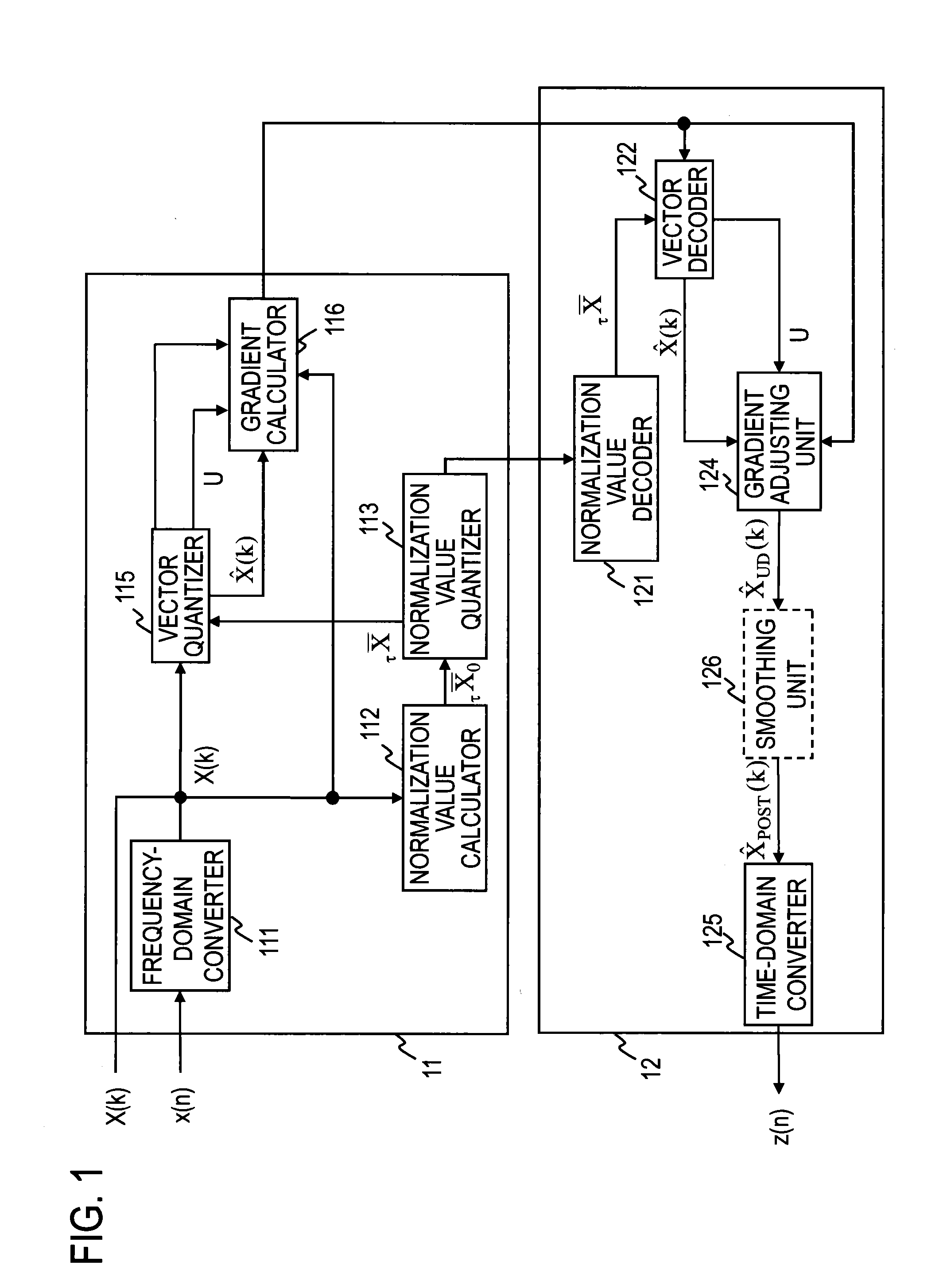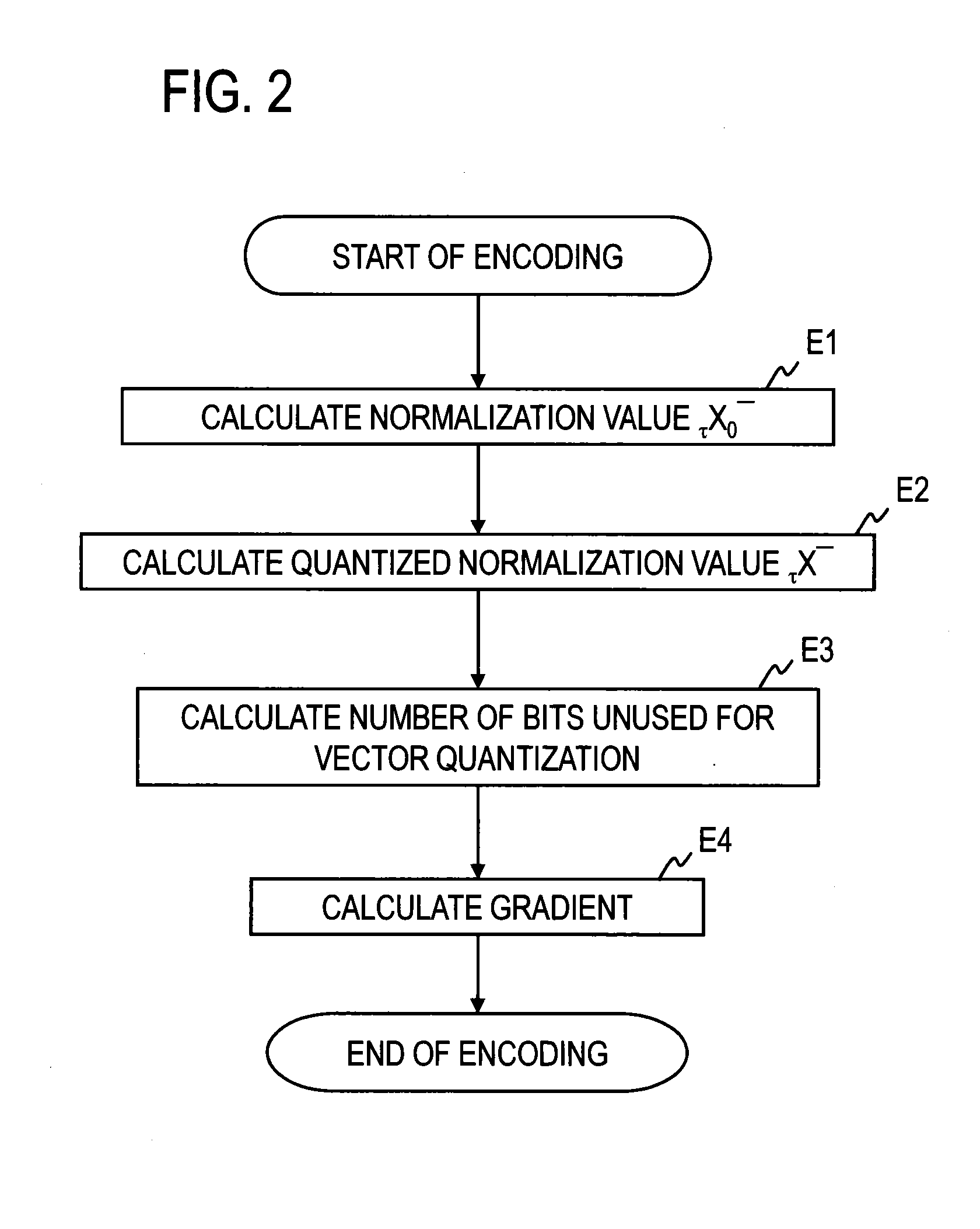Encoding method, decoding method, encoding device, decoding device, program, and recording medium
a decoding method and a technology of a decoding device, applied in the field of encoding or decoding signal sequences, can solve the problems of block noise, perceived noise, equivalent to musical noise, etc., and achieve the effect of reducing quantization error, musical noise and the like, and reducing quantization error
- Summary
- Abstract
- Description
- Claims
- Application Information
AI Technical Summary
Benefits of technology
Problems solved by technology
Method used
Image
Examples
example 1
[0055][Example 1 of Step E4]
[0056]The gradient calculator 116 in this example executes the steps shown in FIGS. 3 and 4 to write index information idx indicating the row number of the selected gradient coefficient vector in the unused bit region.
[0057]The gradient calculator 116 initializes the i, h, and u values to 0, H, and U, respectively (step E41), and proceeds to step E42. When C0 indicates the number of samples in the sub-band, H indicates the number of sub-bands in a single frame that has been vector-quantized in the vector quantizer. When C0 indicates the number of samples, L, in a single frame, H becomes 1.
[0058]The gradient calculator 116 compares i with G (G=L / C0) (step E42) and, if i43 or, if i4. When C0 indicates the number of samples in the sub-band, G indicates the total number of sub-bands in a single frame. When C0 indicates the number of samples, L, in a single frame, G=1. When δ is compared with η, the comparison method is not limited, and any comparison method t...
example 2
[0069][Example 2 of Step E4]
[0070]Step E4 may be executed as described below, for example, as illustrated in FIGS. 3 and 4.
[0071]After steps E41 to E45 are executed, if it is decided in step E45 that flg(b)>0 is not satisfied (flg(b)=0 is satisfied), the gradient calculator 116 increments i by 1 (step E421) and proceeds to step E42. If it is decided in step E45 that flg(b)>0 is satisfied (flg(b)=η is satisfied), the gradient calculator 116 sets MMAX=1 and a=1 (step E48′) and proceeds to step E46.
[0072]In step E46, the gradient calculator 116 compares u−h with 0 (equivalent to comparing u with h); and if u−h>0 is satisfied (step E46), mMAX=3 and a=2 are set (step E47), and the processing proceeds to step E49. If u−h>0 is not satisfied, the processing proceeds to step E49 without changing MMAX and “a”. The remaining part of the processing is the same as in Example 1 of step E4. The gradient calculator 116 here outputs index information idx that can be expressed with the bits assigned ...
example 3
[0073][Example 3 of Step E4]
[0074]In Examples 1 and 2 of step E4, the following calculation may be made instead of Equation (2).
eMIN=Σj=0C0−1∥X(b·C0+j)|−|{circumflex over (X)}(b·C0+j)∥
In Examples 1 and 2 of step E4, the following calculation may be made instead of Equation (3).
e=Σj=0C0−1∥X(b·C0+j)|−γm·|{circumflex over (X)}(b·C0+j)∥
The description of [Examples of step E4] ends here.
[0075]The code (bit stream) corresponding to an modified vector quantization index that includes the vector quantization index and the index information idx written in the unused bit region is sent to the decoding device 12.
[0076](Decoding)
[0077]The decoding device 12 executes the steps of a decoding method illustrated in FIG. 5.
[0078]The normalization value decoder 121 obtains a decoded normalization value τX− corresponding to the normalization-value quantization index input to the decoding device 12 (step D1). The decoded normalization value τX− is sent to the vector decoder 122.
[0079]It is assumed that...
PUM
 Login to View More
Login to View More Abstract
Description
Claims
Application Information
 Login to View More
Login to View More - R&D
- Intellectual Property
- Life Sciences
- Materials
- Tech Scout
- Unparalleled Data Quality
- Higher Quality Content
- 60% Fewer Hallucinations
Browse by: Latest US Patents, China's latest patents, Technical Efficacy Thesaurus, Application Domain, Technology Topic, Popular Technical Reports.
© 2025 PatSnap. All rights reserved.Legal|Privacy policy|Modern Slavery Act Transparency Statement|Sitemap|About US| Contact US: help@patsnap.com



